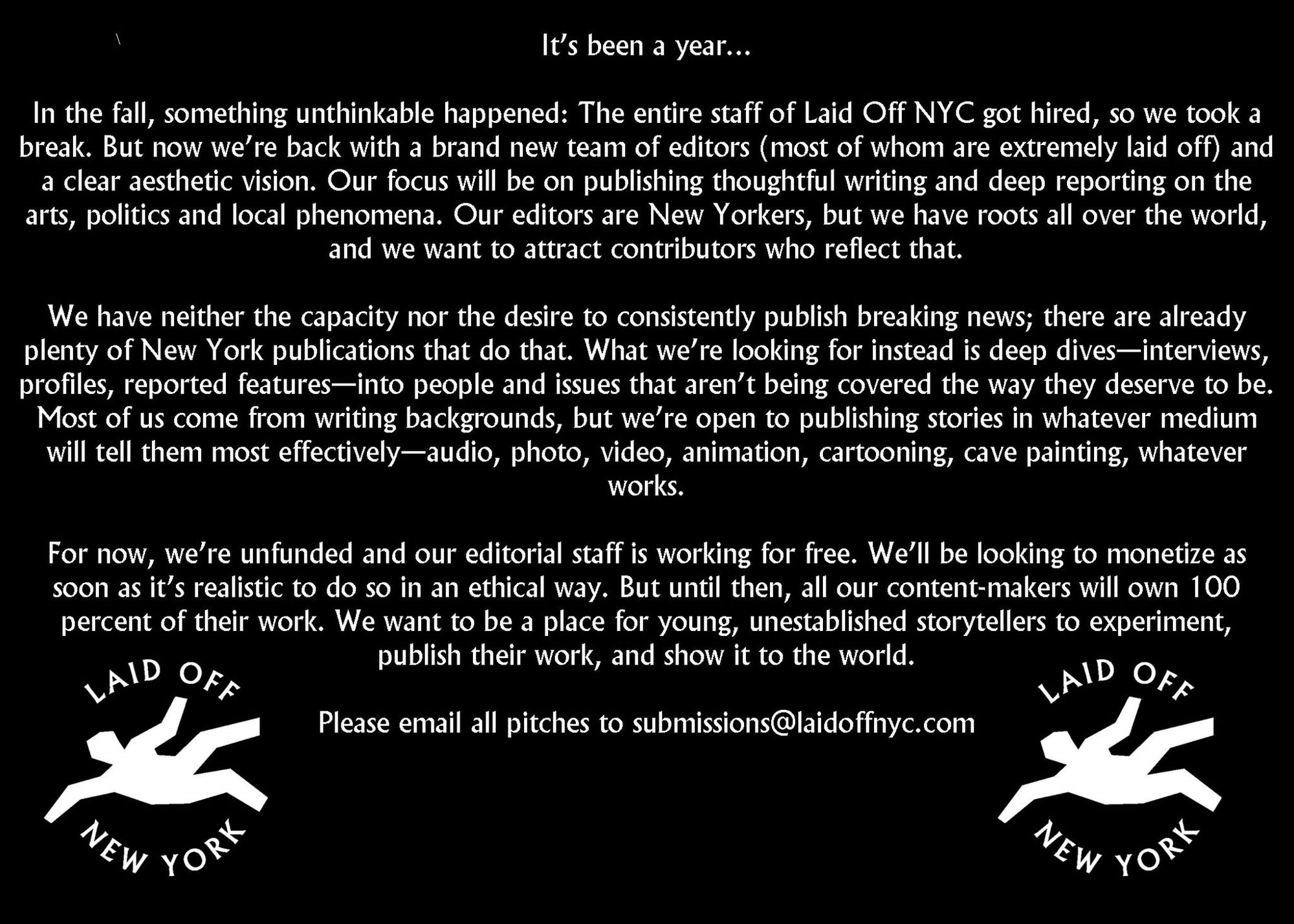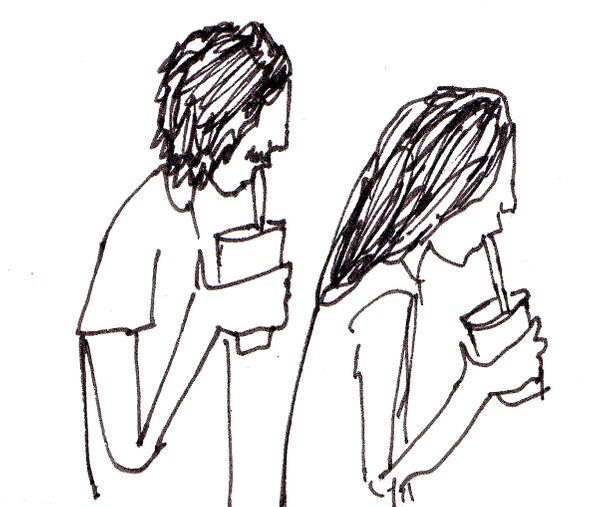Hello and happy 2022! We come to you live today from LaidOffNYC HQ in [REDACTED], New York, wishing you a new year of bountiful Ws and minimal Ls. This January, like last, was a time for us to rebuild and reflect—this time on year 2 of the global pandemic, and year 2 of LaidOff: We were, like so many other little projects, forged in the fires of COVID unemployment and are thus inseperable from the disease.
Everything has changed in the 365-odd days since we gave you our reflections on 2020—A Bad Year and A Farewell—but most things are the same. "In our first official act as the new ruling party of Laid Off NYC, we asked writers to choose cultural objects—pieces of art, memes, fashion trends—and use them to reflect on their years," we wrote then. A year later, we gave our contributors essentially the same challenge, though the prompt was less direct. Below, eight writers and one comic artist give us 2021 in TikTok trends, Verzuz battles, books of poetry, Franco-era Spanish films, sweet potato curry recipes, 18th-century oratorios, classic Italian films, live-streamed plays, and iconic literary flaneurs.
It's been my pleasure to watch the ebb and flow of this publication as our staff—myself included—shifts between stasis and movement, employment and laid-off-ness. Our path this year is no clearer than it was in 2021, but we're stoked to hang around with you all a little while longer nonetheless.
—Raphael H
@ladyyasmina1 Abroad was like, literally life changing #ComingOfAge #SFXMakeup #fyp #smalltowngirl ♬ Mariners Apartment Complex - Lana Del Rey
The meme that TikTok’s algorithm funneled into my “for you” page more than any other this past year also doubled as a diagnosis. Midway through 2021, “main character syndrome” became a fixture in the app’s glossary of types and trends, introducing us to an ensemble cast of preciously deluded patients. At first glance, they all had one thing in common: an unshakeable conviction that each event in life, no matter how mundane, is charged with endless possibility and adheres to a basic narrative progression, starring the self. There is the woman (above) who studies abroad and then returns to her hometown with a magnified sense of self-worth, believing herself to be the “fully realized main character.” There is the student who swans through the library aisles in an attempt to manufacture a meet cute, aspiring to the sort of whimsical luck a heroine in a YA novel might have. Like the rest of their peers, these people smile like they know a secret, and move almost exclusively in slow motion. Lana Del Rey soundtracks their every waking moment. One gets the feeling that they cry only in single tears.
My favorite main-character TikToks hinge on the same soundbite. The original video starts with the user Tanner Tan shimmying to Pitbull and Kesha’s 2013 chart-topper “Timber”—a cheeky indictment of “everybody’s music taste in middle school.” Suddenly, it cuts to him moving down a hall of lockers, appearing guarded, remote, and addled by several indeterminate neuroses. The chorus of Del Rey’s “Ride” resounds in the background: “I am fucking crazy,” Tan whispers in voice-over, “But I am free.” This eight-second character sketch, so specific and yet so familiar, has fostered countless riffs. A family lounges together beneath the sun, save for “that one cousin”—the one in spike-studded leather bracelets and knee-high rainbow socks—who prefers the shade. A herd of cattle graze on a hill, except for one cow, who breaks from the group to wander the wilderness alone. A couple take their children to a playground, but the husband “decides to be the main character instead,” abandoning his wards to watch a lake dramatically.
The media conversation around main character syndrome has often characterized it as performative and conceited. Refinery29 described the meme as one which “indulges that desire to be seen.” Kyle Chayka of The New Yorker wrote that “main-character moments are those in which you feel ineffably in charge, as if the world were there for your personal satisfaction.” On one level, this may be true. But as soul-searching husbands and vagabond cows have shown us, it isn’t always the case: main characters are also liable to eject themselves from the prevailing narrative, seeking solitary respite from the public charade. This complicates the meme’s reputation as a vehicle for narcissism—the feature which unites these protagonists isn’t an appetite for recognition, but rather the possession of an inner life that runs parallel with, yet in many ways remains distinct from, the social script. Beneath the main character trend’s surface appeal lies a surprisingly cutting critique of human subjectivity.
While we all harbor interior monologues, graft symbolic value onto crude reality, or nurture little delusions to keep ourselves afloat, we nonetheless experience our inner lives separately from the ones we live alongside others. The main character meme captures this duality, foregrounding the friction between the real and the imagined. Many of these sketches derive their humor from the slippage that inevitably occurs when people try to actualize their reveries: there is usually some rude awakening, a failure to elicit the desired response, a disconnect between actor and audience. The homecoming graduate attempts to prove her cosmopolitan credentials by introducing her friends to gelato, but they already know what it is. The student at the library purposely bumps into a stranger, but he doesn’t react. In this sense, these TikToks deal in the frustration of fantasy, what happens when one’s private narrative encounters real world turbulence.
There’s something about these characters I find endearing, particularly within the context of another pandemic year. At least for those of us in New York, 2021 teased the possibility of a return to normalcy, an expectation that in the end proved chimerical. Many of the plans we’d made, the scenarios we’d envisioned for ourselves, were snatched away again, and we found that the story didn’t quite go the way we would’ve wanted. But the main character does not exit stage left when such disruptions threaten her moment. She still, after all, can withdraw into that earnest and cinematic imagination, one that invests the bleak and quotidian with the faint glimmer of promise.
—Enzo Escober
If you graphed the levels of hope I felt over the course of 2021, you’d see a jagged arc. It would start at the haunting low of watching an insurrection take place at the Capitol Building and end with another wave of COVID-19, one that tightened against my seasonal affective disorder like a titty twister. The apex would be the August night when Jadakiss, standing defiantly on Madison Square Garden’s stage, rapped over the “Who Shot Ya” beat.
After 18 months of living in a city that was not spiritually built for a quarantine, finally-vaccinated New Yorkers flooded MSG to watch two of their city’s legendary rap groups, LOX and Dipset, battle it out. LOX, Jadakiss’ group, entered the event as the clear underdogs, having a catalog much less celebrated than their opponents’. But then, halfway through, Jadakiss began rhyming to the instrumental of The Notorious B.I.G.’s 1995 classic, a song widely perceived as a Tupac diss and a reclamation of New York as the true capital of hip-hop. By the time Jadakiss had finished his verse, the tables had turned.
The performance didn’t start when the beat dropped, really, but with the blustering speech that preceded it. When Jadakiss saw Dipset using pre-recorded vocals for their songs, he began chastising them: “We’re in the mecca of hip-hop. Why do they not know the words?” It’s no accident that he invoked hip-hop’s New York roots in his tirade. Over the course of the evening, Jadakiss had been slowly but surely rallying his audience behind some notion of what it meant to be from New York—a New York that, for many, was being reintroduced that night. Then, at just the right moment, that beat—its slithering piano line, its dry kick drums, its taunting horns—came knocking out of the speakers, and the audience erupted almost instantaneously.
The “Who Shot Ya'' instrumental has a way of activating a tribal sense of New York pride. Jadakiss must have known this, because he rapped like he was running for mayor. His campaign was founded on a cool stage presence, a fiery wit (“Something hot drop, I cop in all flavors / He’s a dick, you pussy: y’all neighbors”), and, of course, absolutely no pre-recorded vocals. The whole thing was astonishingly, invigoratingly, deeply New York.
Jadakiss wasn’t just making his claim as our city’s preeminent MC; he was reminding us why being a New Yorker is something worth celebrating. It was a reminder I desperately needed. Since the start of the pandemic, I had been holed up in my undersized and overpriced apartment. Meanwhile, the things that made the city worth living in—the socially and culturally rich life promised to us by the countless depictions of this city in popular culture—lay dormant, so close yet so far away. By the summer of 2021, my love for New York was all but dead. Jadakiss held his mic like a surgeon holds a scalpel.
In 2021, Margaret Atwood’s Gilead—the male-dominated, dystopian society I once considered unthinkable—became a reality in various corners of the earth as women were stripped of their rights. The Taliban swept through Afghanistan, shuttering schools and locking women in their homes while America’s right-wing “pro-life”ers gained more momentum than they have in years, inching us closer to a future without abortions.
Sickened by these events, I turned to the small collection of feminist writings on my nightstand, hoping to both assuage my anxiety and provoke my anger. I found what I needed in Life of the Party, a 2019 collection of poems by the spoken-word poet and sexual-assault activist Olivia Gatwood. A fiery and poignant memoir in verse, the book is at once chilling and heartfelt, despairing and buoyant—a testament to the fragility and strength of womanhood and the long fight for gender equality still ahead.
Gatwood’s early poems on girlhood are filled with freedom and dreams (“Once everything was a gift. Once, anything / resembling the thing we wanted was the thing / we wanted”), but her buoyant language and hopeful perspective quickly change as her younger self internalizes the world around her (“we had to dodge & skip through the world like rodents under the boots of men”). Through adolescence, her writing develops a razor-sharp edge: “I slam down the glass until it cracks… I am not afraid of blood, which is also part of being a girl.” There’s a raw truth to her words that highlights a bitter irony: Girls are coddled and primped in youth as if we won’t one day soon have to face seven days of pain and discomfort each month. And as grown women, we are told that bringing life into this world is not our choice.
Life of the Party is a fiery, untethered portrait of femininity but Gatwood is not all anger; she’s also full of tenderness and love, capable of finding beauty in sadness, and forthright about her own vulnerabilities. She’s a self-proclaimed “good girl, bad girl, dream girl, sad girl,” and she wants to “be them all at once.”
In 2022, we need more fervor, less shame. More women fighting for reproductive rights, less talk of masculinity “under threat.” As Gatwood writes, “no matter the mouth it comes from or how they mean it, girl… i’ll never die, i’ll never stop running / through sprinklers or climbing out of open windows.” May women across the world feel this same sense of empowerment and have the freedom to become mothers when they know it to be right.
Luis García Berlanga’s 1953 comedy ¡Bienvenido, Mister Marshall! welcomes the viewer to a sleepy, rural, Franco-era Spanish town whose people, under the new Marshall Plan, are about to be lavished with gifts by the North American saviors of postwar Europe. Mayor Don Pablo—a crass, stout little man, almost sanchopancesco—has been tasked by his superiors with impressing the Americans. He plans a kitschy Andalusian show with empresario Carmen Vargas, figuring the American view of Spain is based in Andalusian stereotypes like flamenco dancing. Later, the townspeople line up like children for Santa at the mall to tell Vargas and the mayor what gifts they want from the Americans. Most of their requests are trivial, like new shoes and farming tools. One young man asks if the Americans can give him a wife. His request is turned down, but Don Pablo suggests a mule instead, since “it’s basically the same thing.”
Not everyone in the town is thrilled. The haughty nobleman and local crank Don Luis, whom no one particularly likes or listens to, hates the yanquis because American “Indians” killed and supposedly ate some distant forebear of his, back in conquistador times. And during an uproarious scene at a town assembly, when the schoolmarm is rattling off statistics about the United States’ superlative industrial production, the parish priest interrupts, declaring that America is the largest producer of sins—“There are 49 million Protestants there!” Later, on the eve of the Americans’ arrival, his dreams are haunted by Klansmen, the Un-American Activities Committee, and jazz music.
When the big day comes, the motorcade of American dignitaries zips through the town, without the faintest regard for el pueblo. The townspeople, who seemed briefly to put faith in the American economic juggernaut over God, are left speechless and broke. Their disillusionment is a fitting, quintessentially Spanish ending to the story. Their ideals are shattered like Don Quixote’s, and after staring in disbelief at the final rear bumper disappearing into the distance, they start tearing down the new decorations and pawning off their possessions. By validating the Spanish traditionalists’ misgivings about America while also ridiculing their reactionary views and feelings of superiority, Berlanga mocks both the conservative nationalism of the Franco regime and the liberal globalism of the United States. As we anxiously await relief or decisive action from our government, ¡Bienvenido, Mister Marshall! cautions us against both the pitiful delusion of benevolent governance and the comical extremes of moralistic, cynical contrarianism.
When I was 22 I frequented healthy (read:diet) cooking blogs, which was how I found this recipe for a curry made entirely from vegetables. It’s so legitimately tasty and simple, it stuck with me even after I became well-adjusted. This is essentially a recipe for a very good and very flexible sauce, which can be served with any combination of vegetables, protein and carbohydrates of your choosing.
2 cups steamed or microwaved sweet potato chunks, peeled
2 tablespoons oil or butter, divided
1/2 yellow or white onion, diced
1 inch piece fresh ginger, minced
Small splash of apple cider vinegar
1 cup unsweetened almond milk (or cow’s, or coconut)
1/2 cup vegetable broth
1 tablespoon curry powder of your choice
½ teaspoon garam masala
1 teaspoon ground tumeric
Something spicy if you like that
Salt and freshly ground pepper to taste
About 2 cups of any vegetables you like, chopped (cauliflower, broccoli, zucchini and peas are my favorite)
Prepared chicken, tofu, or chickpeas
Basmati rice, quinoa, or naan and yogurt, and cilantro for serving
In a large saute pan, heat one tablespoon of oil or butter over medium heat. Toss in the onion and saute until just soft, about 5 minutes. Add the garlic and ginger and saute until fragrant, about 3 minutes. Splash in the apple cider vinegar, stir things around, and let that cook off for a minute. Add the spices and salt and pepper to taste and let it cook for a few minutes. Try a bit and add more seasoning if it needs it.
Carefully transfer this onion/garlic/ginger mix and the sweet potato chunks into a large food processor or blender. Pour in the milk and broth a little at a time, and blend/process, stopping to scrape down the sides, until you get to a consistency you like. Taste again and decide if it’s wanting anything, and add that. Your sauce is ready.
In the same saute pan you used before, heat the other tablespoon of oil over medium heat. Toss in the vegetables of your choice and saute until near-tender. Season with salt and pepper. If you prepared a protein, throw that in now. Pour in the curry sauce and cook over low heat for 5 to 10 minutes, stirring gently and letting the flavors meld and get acquainted with each other. Serve over rice or with naan, yogurt, and cilantro.

Everyone knows George Frederic Händel’s Messiah. Everyone hums parts of the “Hallelujah” chorus, even if they don’t remember it is part of an oratorio composed in 1741. Someone somewhere always plays Händel’s masterpiece around Christmas.
I used to sing it too. Years ago I was in choir. First as a contralto, then as a tenor. To this day, when I quietly follow the parts of the tenor, I contemplate the road not taken, that of music. During those moments I repeat to myself that one never chooses the talents one possesses. I am grateful for the ones I have. I am grateful for the orchestras and choirs around the world.
A few weeks ago I invited a friend (a musician) to The Riverside Church to listen to the New York Philharmonic and the Chorus of Apollo’s Fire perform the Messiah. He fell asleep and woke up just in time to stand up during the “Hallelujah,” following the tradition started by King George II of both dozing off and standing for mysterious reasons.
G. K. Chesterton wrote that the incredible thing about miracles is that they happen. We were late. We’d had a long day. I was carrying a camera and a tripod; he had a suitcase with a pillow and a blanket. (No time to explain.) It took us forty minutes to get from the Village to the Upper West Side. We got out of the taxi on the wrong side of the church. We were sweaty, tired, almost defeated. But when we made it to the entrance we were informed the orchestra was also late. We were the last ones to get in before Jeannette Sorrell came out and started the concert.
Hallelujah!
Never mind the Pollocks, here’s the Nam June Paik, said I to the stormy cultural critic at the MoMA, an hour to kill before a screening of Federico Fellini’s mucho-macho-Maximalist Otto e Mezzo in early December. We wandered into Instant Zen, a room on the MoMA’s fourth floor housing a collection of Paik’s works in assorted mediums. We saw a small toy truck with FLUXUS painted on it and typewritten instructions for a performer to cut off three pieces of their armpit hair and burn the first, taste the second, donate the third. Then there was Zen for Film, a projector sending dust-speckled film onto the adjacent white wall, and in our active boredom we engaged in a mock mini rendition of Waiting for Godot while we waited for Marcello Mastroianni, enlisting an unlucky bystander in our psychotic—
—she held the iPhone camera, ready to be leaving, while we bantered in the June Paik light and I couldn’t believe the tempestuous cultural critic’s mouth when he said, my friend, you seem to be quite drawn to Minimalism in aesthetics, yet your work contains none of its concision,
Well, well, touche amigue, and remembering a quote from Fellini’s much-despised critic character in the much beloved Otto e Mezzo, I turned and said to my critic, your subject has none of the merits of the avant-garde, while having all of its shortcomings,
Eppure… (And yet…)
The charge leveled against me holds holy water. I am drawn in by Minimalism’s silent prayer—
its economy of gesture;
the grace afforded
to the particle of dust
wipes clean the grime with the promise of time;
an empty room
where only the essential may enter,
inviting one to contemplation of
—until a Maximalist fanfare appears and I am diverted towards its carnivalistic, fanfarronic celebration of all that is sordid and superfluous, denying its author no indulgence, including all, sparing no expense, cramming every impulse, every whim, every thing into an enormous picture, difficult to see, no doubt, but expressing something so simple, so true, so vivid and universal in its fantastically misguided particularity that one forgives the author, indeed adores the author, despite their many faults and missteps and pretensio—
—are you two done yet? said our reluctant iPhone director. We thanked her, exit she, and after reviewing the contents of the iPhone film, we both agreed that there could be more dancing, there could always be more dancing, exit we, dancing.

The refrain of “Seasons of Love” from Rent drifted into my mind as 2021 came to a close: “How do you measure / Measure a year?” That song’s answer—sculpted by an ensemble of voices in response to a character’s death from AIDS—takes the form of a list. A year is five hundred twenty five thousand six hundred minutes, moments, journeys to plan. A year is daylights, sunsets, and midnights. A year is bridges burned, cups of coffee, seasons of love.
There is something very satisfying about a list. It accumulates details but remains snappy and elegant. It condenses free-floating feelings into palpable visuals. Each image signifies, and encapsulates, a larger story—sometimes even multiple stories. My rear view of the past year can be compressed into another theater-related list: twelve months, seven plays, two studio apartments (different cities), and one laptop. This was the Mint Theater Company’s “Silver Lining Streaming” program, a series of high-quality recordings of pre-pandemic productions, released for free and easy at-home screening.
The Mint’s mission is to stage “worthwhile plays from the past that have been lost or forgotten.” And the virtual series dunked me like a teabag, at regular intervals, into a bygone world of softly lit, wallpapered drawing rooms on both sides of the pond.
January kicked off with a factory-owning Ohio family named the Rodmans (no relation to me!), who hire thuggish, out-of-town strikebreakers to end their workers’ walkout (Days to Come by Lillian Hellman, ca. 1936). In February, I watched a spunky Irish housemaid enter into a chilly marriage with her employer’s slick, middle-aged brother (Katie Roche by Teresa Deevy, ca. 1936). March took me to an all-girls boarding school in Ireland, where alliances shift and plots sprout in the teachers’ lounge (Women Without Men by Hazel Ellis, ca. 1938). During the spring, and into the summer, I dipped into the lives of a couple testing the bounds of their open marriage (Yours Unfaithfully by Miles Malleson, ca. 1933); an aging husband, wife, and brother-in-law struggling to maintain their country manse (A Picture of Autumn by N.C. Hunter, ca. 1951); and a mother and daughter hashing out the pluses and perils of wedded bliss (The Fatal Weakness by George Kelly, ca. 1946). Finally, as a holiday gift, the Mint presented a story of two young adults seeking a no-strings-attached fling (Hindle Wakes by Stanley Houghton, ca. 1912).
Labor disputes, careerism, caring for graying parents, polyamory, adultery, hookup culture—the chintz notwithstanding—felt less remote, and more uncannily timed to 2021, with each immersion.
Walking, biking and running have become more popular during the first two years of the pandemic. So has Swiss author Robert Walser, one of the 20th century’s great flaneurs. A new biography published this year lays out the facts of his life: born in 1878 in a part of Switzerland where both German and French are spoken; itinerant and poor in his youth; committed against his will to a sanatorium in 1929 with a diagnosis of schizophrenia; found dead of a heart attack in 1956 near the asylum in a field of snow where—presumably—he was out for a walk.
Many of Walser’s works, including his novella The Walk, are structured around journeys, strolls or rambles. His protagonists are perpetually awestruck by the world’s beauty: “I love the stars,” says one, “and the moon is my secret friend.” His narrators deem “everything small and modest to be beautiful and pleasing” and “all that is big and exacting…fearsome and horrid.” They take pleasure in submission: “I want to be industrious and obey whoever deserves to be obeyed,” announces the protagonist of A Schoolboy’s Diary. They are small, quivering, joyful men, often with tears in their eyes.
As they walk, they enter raptures that distend time. Walser’s narration swells as he denounces “blustering, dust-churning” automobiles or improvises an ode to a disinterested schoolgirl, crescendoing in moments that glitter with precious detachment from the world. In these passages voice justifies voice, for its own sake, and takes up its own space and time. That latter point is most obvious when, after “humbly request[ing] in advance the reader’s pardon” for the “lengths, breadths and heights” of his narrative asides, he interrupts himself: “God bless my soul! It’s high time I went over to Frau Aebi for my dinner, or lunch.” Here, the action of the plot is collapsed into the act of its creation. Walking becomes writing. The narrative moves to the cadence of the protagonists’ thoughts, not his footsteps.
Walser’s work has resonated with me and others during the pandemic perhaps due to what Susan Sontag calls his “depressive’s fascination with stasis.” Walser was poor, ill, often underemployed; he had plenty of free time but lacked freedom. His walks, Sontag writes, were a way of “obsessively turning time into space,” an alchemy many of us have indulged in these last two years. But in his fiction time is created, not spent. Instead of flowing a minute at a time, it eddies, blossoms into rapture and soliloquy. When he revels in the voice of a self-flagellating, layabout job-seeker or writes mischievously on the “delicate subject of trousers,” his art is the act of creating nothing from nothing. Rejecting pretension and aspiration, he burrows into his circumstances and becomes a subterranean, smiling creature. “The hours joke around with me, and I joke around with them,” he writes, “and I could wish for no more delightful entertainment.” What better attitude to bring to year three?

*Lead image: EIC Raphael and his girlfriend Erin drinking slushies on Canal Street, by EP Andrews.



